The Response - UWA Staff - The University of Western Australia
The Response - UWA Staff - The University of Western Australia
The Response - UWA Staff - The University of Western Australia
You also want an ePaper? Increase the reach of your titles
YUMPU automatically turns print PDFs into web optimized ePapers that Google loves.
have a plan to engage with all such pr<strong>of</strong>essional bodies and the leading individuals within those pr<strong>of</strong>essions, in<br />
order to maintain and advance pr<strong>of</strong>essional standards and receive acknowledgement or accreditation <strong>of</strong> their<br />
courses from such bodies. <strong>The</strong>se bodies could be engaged more fully through continuing contacts with their<br />
appropriate School or department…’<br />
5. Internal operations<br />
‘I would like to see a stronger, more positive message here, that excellence in management, alongside and in<br />
support <strong>of</strong> excellence in teaching and research, is a key component <strong>of</strong> institutional success, and should be<br />
proclaimed as an objective <strong>of</strong> note. (Our last AUQA audit commended the <strong>University</strong> as well-managed which<br />
attracted much interest from other universities, senators, bureaucrats, etc.)’<br />
‘It is essential that the basic business operations (Finance, HR etc) understand the core business <strong>of</strong> the <strong>University</strong>,<br />
and work positively to support teaching and research. While it is important that <strong>UWA</strong> complies with all appropriate<br />
regulations, these are not the core activities <strong>of</strong> the <strong>University</strong>. In too many organisations, the bureaucracy can<br />
develop its own “raison d’etre”, which may not align with the organisational needs and direction. Importantly, the<br />
basic business operations are <strong>of</strong>ten a “shop front” to the outside world; therefore, they need to be aware <strong>of</strong> the<br />
impact their interactions may have on perceptions <strong>of</strong> the <strong>University</strong>.’<br />
‘I foresee a discussion (re)emerging around the subject <strong>of</strong> selectivity in the context <strong>of</strong> a low/no growth<br />
environment. Research selectivity/concentration is well understood, but in other areas – educational, community,<br />
services and support – we may struggle with comprehensivity against a high end/high cost research intensive<br />
mission with its consequential impact on infrastructure, overheads and institutional management. In a tight<br />
budget scenario, people will want to know what will give. <strong>The</strong> principal answer at the moment is – pr<strong>of</strong>essional<br />
staffing, capital and discretionary funding. Pressure for discussion around size/scale, student and discipline<br />
mix, the physical campus(es), the array <strong>of</strong> community services/activities and institutional functions we can<br />
sustain, beyond the scope <strong>of</strong> simple operating efficiency gains; seems likely for the next iteration <strong>of</strong> our strategic/<br />
operational planning (2014–2018), as there is little confidence that there will be a significant (unrestricted) funding<br />
improvement from either government or student contributions to pay for our aspirations.’<br />
‘What about reinforcing the development <strong>of</strong> a high performance service culture for support areas? We need to be<br />
open to all models <strong>of</strong> delivery and embrace efficiency and effectiveness through process re-engineering in order<br />
to free up resources.’<br />
‘I have been struck by the number <strong>of</strong> separate processes that create a very complex overall system. Some<br />
examples are: numerous web-based systems that don’t integrate (or at least not well), which creates extra work;<br />
reams <strong>of</strong> manuals but very little best practice guidance available (everyone seems to do things differently across<br />
the Uni and therefore there is very little consistency between business units); a Web Office that is not connected<br />
with the IT department, meaning that website support is irregular; and a general lack <strong>of</strong> communication between<br />
the ‘support’ departments <strong>of</strong> the <strong>University</strong> so that, for example, Research Services is not clear on how HR or FS<br />
operate even though their processes are connected from a School perspective. Proposal 13 <strong>of</strong> your discussion<br />
paper will no doubt incorporate some <strong>of</strong> these issues, but I was hoping to see something more specific about<br />
streamlining and potentially restructuring; perhaps this is implied, but I certainly hope that the <strong>University</strong> will be<br />
analysed as a whole, rather than its separate parts. Too <strong>of</strong>ten at <strong>UWA</strong> individual problems are analysed and<br />
resolved, without looking at the big picture.’<br />
20 | www.uwa.edu.au



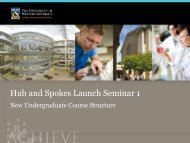








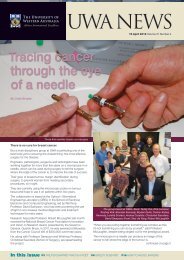
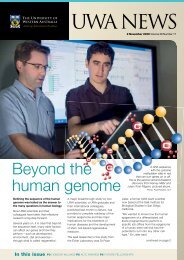
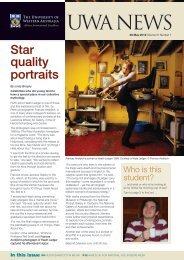
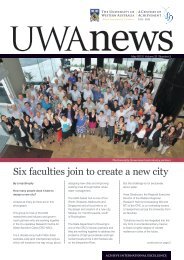
![Issue 13. 6 September 2010.pdf [PDF File, 1.7 MB] - UWA Staff - The ...](https://img.yumpu.com/26619782/1/184x260/issue-13-6-september-2010pdf-pdf-file-17-mb-uwa-staff-the-.jpg?quality=85)